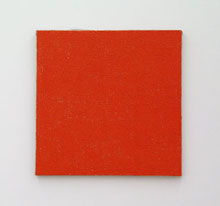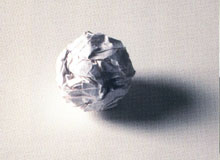 |
|||||||||
|
|
| ...GALLERY EXHIBITS 2002 | ...A Painting and a Sculpture - Sally McIntyre | |||||||||
|
A Painting and a Sculpture Sydney-based curator Nicholas Chambers is philosophical about the inclusion of Scottish artist Martin Creed as one of the artists in ‘A painting and a Sculpture’, an exhibition installed at The Physics Room this month for its 2nd showing, after a debut late last year at Melbourne project space 200 Gertrude Street. The show, which pairs an established Australian and an equally well-known international artist in a carefully spare frame of gallery white, is deliberately small-scaled and tightly focused, all the way from its title to the positioning of the works: one small painting in a monochromatic hue of violent chemical orange, hung directly above one small white sculpture, nestled in a white corner of the room, on the bare wooden floor. The painting is by John Nixon, an Australian artist represented in Christchurch by Jonathan Smart Galleries, who has excluded all colours but orange from his palette since 1995. The sculpture is the Creed work - a screwed up piece of paper, which arrived in New Zealand with all the documents appropriate to an artist of his stature, but in its exhibited state is incidental to the point that it could easily be rubbish left behind by a gallery goer. Chambers’ stresses Creeds’ inclusion in the show happened "before the whole Turner Prize catastrophe" and looks wearily down at the sleeve of his immaculate Fred Perry raincoat, wanting to leave the whole issue of art in the mass media behind. His careful curation stresses almost the opposite stance to the bombast which the Turner Prize invokes, providing instead a scale of exhibition which invites a certain intimacy with work which is in itself, small in its focus. This, Chambers says, is for many reasons, many of them practical, the rest born out of a theoretical focus on practical issues: The small-scale exhibition can travel, as it has here, to other countries. The limits which funding and time circumscribe on exhibitions should be seriously considered factors in the showing of art work. A massive scale group show of contemporary art takes time and money to put together, which no independent art space or curator can afford, and sometimes sets up a context for work which is both inappropriate and uninviting for the individual viewer. Contemporary art, in Chambers’ view, can also, and perhaps needs to, be seen in a context which takes signs away from the work in order to preserve its autonomy: to reveal, rather than conceal it. The resulting exhibition, for all its subtlety, leaves you with little to think about, no narrative to ponder. As an exhibition it is formal, trading solely on the tension between the two works, between their media, between what is there and what is excluded. It also casts the viewer in a certain position, inviting them into a dialogue where there are no signs pointing to what should be thought or what parameter should be drawn around the two works. In its back-to-basics openness, it seems didactic, somewhat like a Visual Arts version of the Dogma 95 film group’s manifesto for filmmakers. It also allows for extended individual pondering: the sculpture is humerous, and causes reflection upon the nature of the plastic arts, and appears gestural, energised, as compressed as a knotted forehead. Its pairing with the vivid orange canvas, which if all colours denote an emotion, is nothing found in nature, sees the latter become a Rothko-like meditation on the flat surfaces of our age. The show leaves an intellectual, graceful, rather robust taste in the mouth, far from the saccharine candy floss, overdetermination and general weariness that attends many shows in galleries geared toward a mythical "general public". ‘A painting and a Sculpture’ is nothing more, and nothing less. For his first New Zealand exhibition, Creed has appropriately slipped in through a back door held open by Chambers, avoiding the fanfare normally associated with international stars, to do what he does, which is make work that, whatever the scale, looks like ‘anyone could do it’, and belies any notion of art as a display of recognisable skill in favour of the simplicity of concept and its expression in incidental gesture. This is a showing of such work as though the media furore created by the Turner Prize never actually happened, which is, perhaps, the only way it is possible to 'view' such work in the first place. Despite the Institutional Theory ironies inherent in Creed's practice, which are fun, and want you to laugh at them (as could be seen during the Physics Room's exhibition, where two acts of tongue-in-cheek vandalism perpetrated on the work saw it, firstly, uncrumpled and spread out flat, and later, surrounded by a hastily crumpled team of identical replicas: you imagine Martin Creed might have done the same thing himself while still at Art School), such dis-informative media attention can only serve to further conceal, obscure and mystify contemporary art. 'A Painting and A Sculpture', in its deliberate formal promotion of a stripped-back model in which contemporary art can be adequately viewed, directly addresses such issues, saying that the solution to being swamped by information and images in the Age of Mechanical Reproduction is to focus narrowly on the things that are relevant - in this case, the actual physical work of art, which is, in all its nakedness, right there in front of you. It builds an alternate model for the global dissemination of artworks which does not rely solely on their presence as Internet images but preserves them in their full materiality. This can also, if you like, be seen to tap into wider issues regarding the information society in which we currently have more information available to us than ever before, but, paradoxically, most of that traffic is extraneous and it's constant, high speed barrage can easily cause individuals to become less discriminatory in their reading, or even to suffer burnout. Along with the concurrently shown exhibition 'A Painting and A Photograph', also curated by Chambers for the Physics Room, which pairs two more emerging artists under the same curatorial model, the show, additionally, serves to remind that Creed, and other publicly lauded artists, such as Victoria's Ricky Swallow, are also, fundamentally, artists who make work, and are, in doing so, merely the tip of the iceberg of contemporary practice in which hundreds of thousands of people actively work as artists, focusing on a huge variety of important formal and narrative issues within their efforts. These people will continue to make work, as the vast majority of Artists do, despite having a spate of aphids on their camellias, only having a BFA (hons) rather than an MFA, and not winning the Turner prize this year. This article also appeared in Presto Magazine A Painting &
a Sculpture
|
|||||||||

